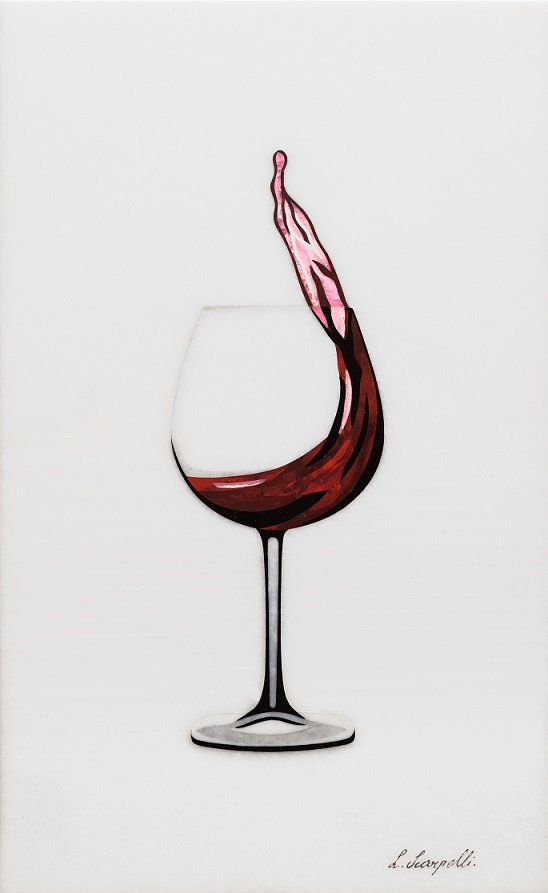Glass of Wine

Tuscany is the best-known and most media-focused region of Italian wine in the world. Living here is the dream of many, ready to immerse themselves in the charm of the union between wine, landscape, beauty, culture and lifestyle.
The artist takes inspiration from the wine named "Black Rooster" that is the symbol of Chianti Classico produced in the area of Chianti, in the countryside of Tuscany, where some of the most famous winery are located.
The name of this wine comes from a legend: after years of bloody war between the Republic of Florence and that of Siena for the control of the Chianti territory, it was decided to put an end to the war and to determine the borders of the two republics through a singular competition.
On a designated day, at the first cockcrow, a knight would gallop away from their respective cities and the border would be drawn at the point where they met.
The Sienese chose a white rooster to send off their knight and in the previous days they treated him with all the comforts and fed him at will. The Florentines instead chose a black rooster which they placed in an uncomfortable cage and left it to fast for a few days.
On the day agreed for the challenge, the black rooster of the Florentines, now exasperated by hunger and the uncomfortable cage, crowed long before dawn and the knight was able to leave with a decisive advantage over the Sienese one, whose rooster, well sated and relaxed, he woke up and sang long after the first light of dawn.
Thus it was that the knights met just a few kilometers from Siena, near Fonterutoli where the border between the two Republics was placed.
The Vine, the Grapes and the Wine are symbols of Rebirth, of Love, of Peace, of Joy, of revenge on Death, Joy, Fertility, Abundance, Patience, Celebrations and Cheerfulness.
In ancient Greek mythology, Dionysus, the god of wine and fertility, is depicted in most sculptures and statues holding a grape in his hand, which gave the fruit a connotation of abundance and fertility, but also of debauchery and drunkenness.
Hellenic tradition traces the origin of the Vine to the death of Ampelos, a young man loved by Dionysus. Ampelo was disarmingly beautiful, with a bright look and a honey voice. Dionysus is seduced by it to the point that he becomes obsessed with it, devoured by the fear of losing it. The god who knows no suffering is overwhelmed by the fear of losing his love. Dionysus, apprehensive, begins to give the boy suggestions to avoid the worst dangers. One day he tells him to pay attention to the bull's horns. And here Ate, divine personification of error, convinces Ampelo to caress a bull, play with it and ride it. The bull is overcome by fury and unhorses Ampelo, then being gored to death by the animal. Dionysus is destroyed, the god who cannot cry now cries and learns to suffer. By dying he left the pain to the god who ignores pain. Eros tries to console him by inviting him to fall in love again and telling him stories of death and rebirth, but there is no remedy. Dionysus' tears, bathing Ampelos' lifeless body, transform him into the Vine. Her tears fused with the blood of her beloved turn into wine, a very sweet nectar capable of confusing memory, subverting it and reshaping it.
In Christian religious services, wine has an extremely important role: it symbolizes the blood of Christ, reminding Christians how Jesus sacrificed himself to atone for their sins. It is also used to commemorate the Last Supper, as Jesus himself referred to the wine as his blood and the unleavened bread as his flesh during the last meal with his disciples.
In the profane field wine is defined as the nectar of the gods, it is also a symbol of fertility and therefore of life; it symbolizes being together, social justice, because the end-of-year celebrations, ultimately, remain a community celebration. It is no coincidence that families meet again, friends meet again, and a bond is celebrated for which wine, in Western society, has always been a fundamental medium. It is no coincidence that agreements, in the West, have always been celebrated with wine.
Used stones: Langue D'Oc, Rhodocrosite, Onix Afyon, Belgian Black Marble.
Year of composition: 2022
Size: cm 40x70
Artist: Renzo Scarpelli
An original and authentic hand-made artwork created whith the antique technique of Commesso Fiorentino which is unique for Florence.
Commesso Fiorentino was born with Medici family, one of the most important families in Florence, in the second half of 1500.
The research of the stones is made by the mosaicist that must be able to choose from a rich and wide range of shades and veins: for this reason the artists personally search and collect the stones retracing the paths of the Medici researchers.
The processing starts by drawing the subject on adhesive paper, that is then cut into small tamplates that will be attached to the variegated shades of the stones following the visual instinct, the innate gift of the artist and his perfect knowledge of the materials. The shape of the little piece will be cut by hand with a chestnut, cherry or hazelnut wood bow and an iron wire that flows with abrasive powder and water. It creates a very precise and inclined cut to form the essential spaces to accommodate the glue, made by artisans with beeswax and pine tree resin. The different stones are previously glued onto a slate surface which acts as a support during the cutting and filing phase. The various pieces which form the composition are adjusted in shape with diamond files, glued together so that the joints are invisible, flattened and finally polished in order to create a perfect decorative harmony showing the colors of nature in all their radiance.
